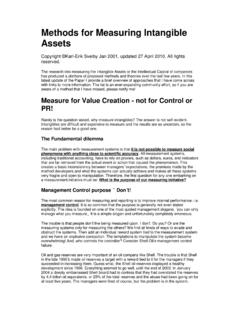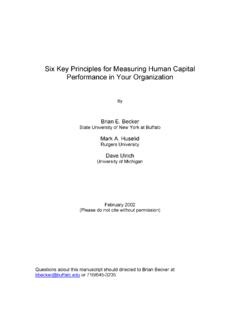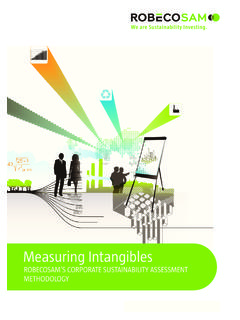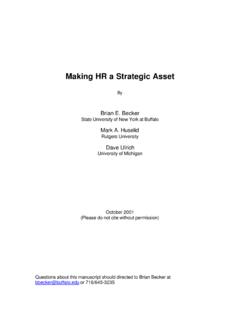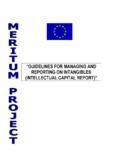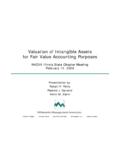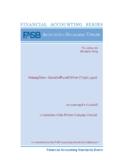Transcription of Corporate Reporting of Intangible Assets: A …
1 Corporate Reporting of Intangible Assets: A Progress Report This analytical report was discussed and derestricted at the OECD Corporate Governance Committee meeting, 18-20 April 2012. For further information, please contact Ms. Alissa Amico, Policy Analyst, April 2012. TABLE OF CONTENTS. ABOUT THIS PAPER AND ACTION REQUIRED ..3. INTRODUCTION ..4. PART I. COLLECTION AND MANAGEMENT OF IA INFORMATION ..5. Motivation and resources for data collection ..5. Available methodologies and instruments ..6. PART II. DISCLOSURE OF INFORMATION ON intangibles .
2 10. Factors affecting external Format of disclosure ..12. Corporate governance and IA disclosure ..13. PART III. USES OF intangibles Reporting ..14. PART IV. POLITICAL ECONOMY OF REFORM ..16. PART V. POLICY OPTIONS ..19. ANNEX I. MATERIALS PROVIDED TO THE MINISTERIAL MEETING ..21. Key messages ..21. Summary of the report ..21. ANNEX II. METHODS OF MEASURING intangibles ..25. REFERENCES ..29. 2. ABOUT THIS PAPER AND ACTION REQUIRED. At its last meeting, the Committee agreed to contribute to the Organisation's two-year horizontal project on New Sources of Growth: Intangible Assets, with a report covering the Reporting of Intangible assets (IA) and progress made in this area in recent years.
3 This report provides an update on the nature and quality of Reporting on Intangible capital in member countries, building on prior work of the Committee in this area. This report explores four interlinked issues related to Reporting of Intangible assets, namely: 1. collection and management of information on intangibles , 2. external Reporting on intangibles , 3. use of such Reporting by analysts and investors, and finally 4. political economy of reform. The report seeks to shed light on potential reasons for the varied adoption of intangibles Reporting by companies and explore factors accounting for this.
4 In its concluding section, it outlines several potential options available to governments interested to facilitate better intangibles disclosure. As agreed by the Committee during its November 2011 meeting, an abstract of this paper as well as key messages for the May 2012 OECD Ministerial were approved by the written procedure of the Bureau. These are provided in Annex I of this paper. This paper was de-restricted by the Committee during its April 2012 meeting. 3. INTRODUCTION. Already in the early 1990s, the importance of Intangible resources and the difficulty of accounting for them were raised and has grown steadily ever since.
5 Today, Intangible assets (IA) such as employee skills, knowledge, trade secrets software, copyrights and patents, customer and supplier relationships are increasingly recognised as important Corporate assets, contributing significantly to a firm's competitiveness. Recent years have even seen the rise of a "conceptual company", characterised by low relevance of physical assets in favour of Intangible intensive Estimates of the value of intangibles , particularly in human capital intensive, high technology, innovative companies have increased, though they vary by country.
6 For example, finance directors surveyed as part of one study believed that 50% or more of Corporate value is attributable to Intangible assets (APCA, 2010). At the same time, the ability to incorporate IA in current accounting frameworks appears to be limited2 and hence, the value relevance of accounting information has deteriorated, especially in sectors characterised by high Intangible capital. This observation raises serious questions about the continued relevance of financial Reporting and places growing expectations on non-financial Reporting to bridge the information gap.
7 There is a growing consensus among practitioners and policymakers that better reflection of intangibles is required in non- financial Reporting in order to improve its relevance to users. Much academic research has focused on exploring this question, and in so doing, trying to establish the value of improved IA Reporting for company valuations or access to credit, which has proven difficult given concerns about causality. Despite this active interest in promoting IA Reporting , progress appears weak. Information about the adoption of IA disclosure frameworks by companies is not readily available.
8 However, there are indications that adoption has not been widespread. This is indeed the central issue that this report attempts to explore by examining the entire chain of management of IA information, from collection of data and asset management, to Reporting of intangibles information by companies and its use by investors and analysts. As a first step, Part I of the report examines the incentives and challenges faced by executives, management and boards in collecting information and managing IA assets. While the motivation for executives to adopt relevant management tools should be in principle strong, the assumption needs to be examined in light of practical obstacles and organisational dynamics.
9 The incentives for disclosure of information on intangibles are examined in Part II of the report, which seeks to present a picture of current Reporting practices and establish how and why companies choose to communicate IA information. 1. Zambon (2009) refers to the "conceptual company" as one implementing flexible business models, simultaneously delocalising low knowledge activities such as manufacturing or distribution. 2. One prominent study investigated market-to-book value ratio for S&P 500 companies and concluded that that over 80% of company valuations were not included in the financial statements (Lev, 2002).
10 Likewise, Beattie and Thomson found that the mean market-to-book ratio of UK FTSE 100 companies rose to 7 in 2010, from of in 2005 (ICAS, 2010). That said, such studies often assume that the difference between market and book values of companies is necessarily attributable to Intangible capital but other factors such as future expectations are important. 4. Part III of the report examines the use of IA Reporting by analysts and investors, seeking to establish whether it is valuable in satisfying specific information gaps and improving narrative Reporting more generally.










